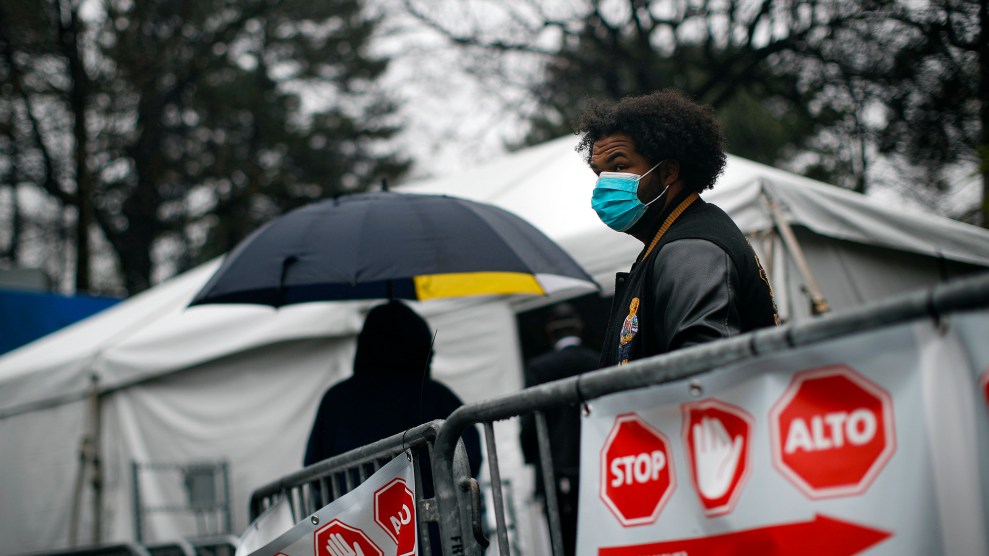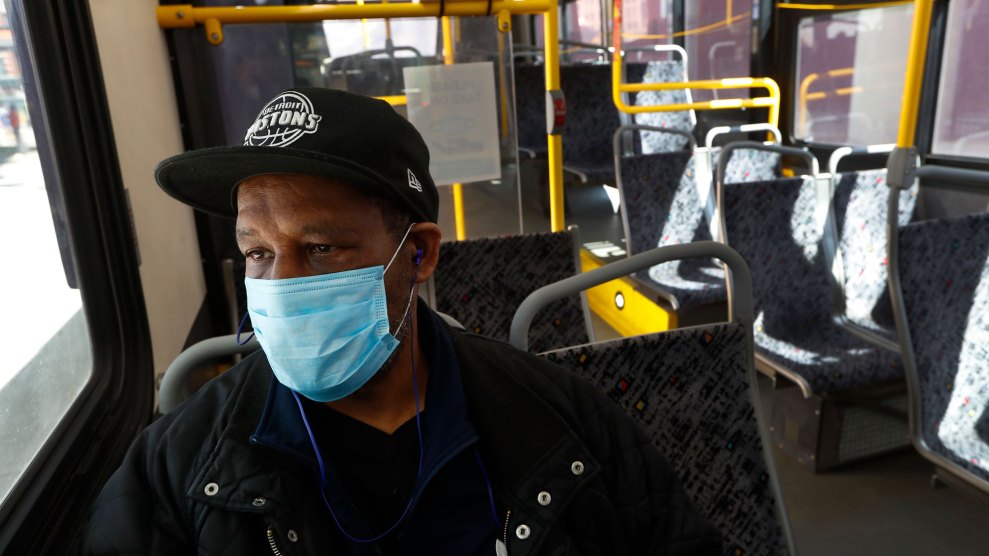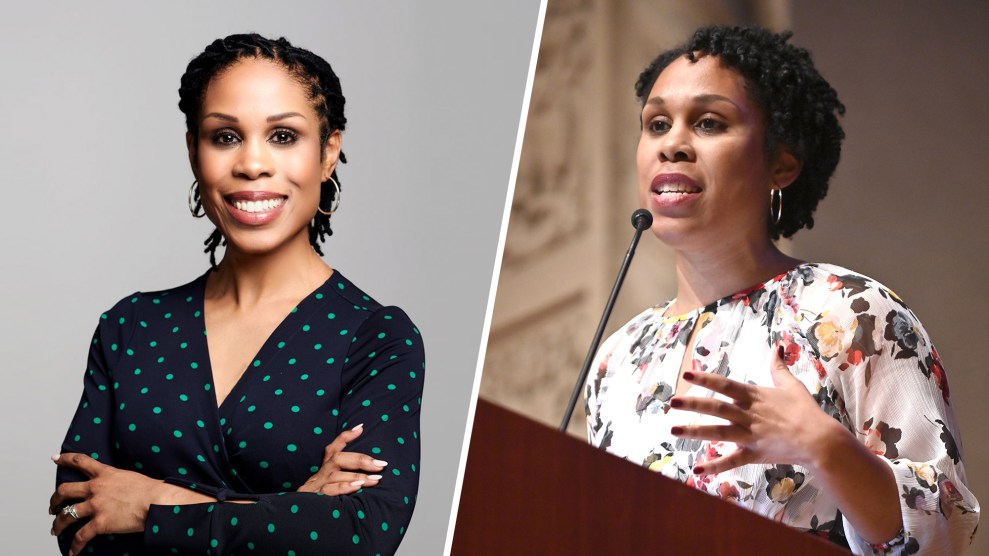
Patients wait in line while wearing protective masks and gloves for a COVID-19 test at Brooklyn Hospital Center in Brooklyn.John Minchillo/AP
On March 16, as Idris Elba announced to the world that he had tested positive for the coronavirus, the British actor suddenly became the most famous Black person on both sides of the pond to publicly disclose a positive status. But he didn’t stop with the disclosure; the next day he offered a stark warning: “There are so many stupid, ridiculous conspiracy theories about Black people not being able to get it,” Elba lamented. “That is the quickest way to get more Black people killed.”
He continued, “Please understand that you can get it, all right? Stop sending out these stupid WhatsApp messages about Black people not getting it. That’s ridiculous. You’re making us all look stupid. Just know you have to be as vigilant as every other race. This disease does not discriminate.”
Elba was alluding to a messy web of conspiracy theories that, while not exclusive to Black communities, signal a deep distrust of medical establishments and the governments tasked with overseeing them. The coronavirus pandemic, perhaps unsurprisingly, has brought them to the fore. Shortly before Elba’s announcement, for instance, French-born NBA star Rudy Gobert mocked the severity of the virus by playfully rubbing his hands over the assembled media’s microphones; it went viral. (So too did a Gobert tweet from a year earlier endorsing the work of Dr. Sebi, a self-proclaimed herbalist and healer who claimed to have cured cancer and HIV with a strict dietary regime.) And just before Elba shared his diagnosis, Ebro Darden, one of the country’s most popular hip-hop radio personalities, ran a segment on his Hot 97 show, “Ebro in the Morning,” that came pretty close to endorsing the so-called 5G conspiracy—one that, in its loosest interpretation, suggests that physical infrastructure is making nearby residents sick and has been promulgated by R&B star Keri Hilson, among others. “Tell your truth, mama!” Ebro told his listeners. “There’s nothing wrong with thinking about it, whether it’s factual or not, it should cross your mind.”
For some, conspiracy theories like these are relatively easy to shake off. But they’re not so far-fetched if you consider, say, the work of Erin Brockovich, or the reality for mostly Black residents of Flint, who still don’t have clean drinking water. As Anna Merlan, author of Republic of Lies: American Conspiracy Theorists and Their Surprising Rise to Power, recently explained on NPR, conspiracy theories often grow in communities where people feel “locked into their circumstances” and “shut out of systems of power.” And when faced with a lack of reliable data, things get murkier. One recent Pew Research study, for instance, found that three in 10 Americans believe that the coronavirus was developed in a Chinese lab, though the theory that it was created by humans as a weapon or anything else has been repeatedly debunked.
These feelings can be particularly acute in communities of color, particularly Black communities, that have faced generations of dehumanizing scientific exploration based on racist junk science. “When there are current and past inequities, and there’s also a vacuum of information, people can develop counter-narratives to fill that void,” says Oni Blackstock, the assistant commissioner for the Bureau of HIV/AIDS Prevention and Control in the NYC Health Department.
And these inequities are not just an issue of the long-ago past: Just recently, French doctor Jean-Paul Mira, the head of the intensive care unit at a well-known hospital in Paris, suggested that European researchers test prospective COVID-19 vaccines in Africa. “If I could be provocative, shouldn’t we do this study in Africa where there are no masks, treatment, or intensive care, a little bit like we did in certain AIDS studies or with prostitutes?” Setting aside for the moment the fact that there are, in fact, masks, treatment, and intensive care units on a continent of more than one billion residents, Mira’s comments are proof that there are still people in the world who consider Black bodies to be sub-human testing grounds. And there’s still reason for Black people to distrust the medical establishments of Western countries.
“I felt [the coronavirus] was a complete hoax,” Rahmell Peebles, a 30-year-old Black man living in New York City, recently told the Associated Press. “This thing happens every two or four years. We have an outbreak of a disease that seems to put everybody in a panic.”
He added, “I’ve just been conditioned not to trust.”
“I do think a lot of times these [conspiracy] theories are rooted in a reality,” says David Malebranche, a doctor and associate professor at the Morehouse School of Medicine. “When we look at particularly the medical profession and the history of medical racism [and] experimentation on black bodies, it’s not that folks are making this up or pulling this out of the crack of their ass and just saying like, ‘Oh, you know, everyone’s out to get me and there’s no foundation to it.’”
But now this problem is perhaps more urgent than ever: Black people have disproportionately been infected with and died from the virus—thanks in part to the increased likelihood that they have pre-existing conditions like heart disease, asthma, and diabetes. “The people who understand how racism works and that racism is a root cause, a fundamental cause of our so-called racial health disparities, now understand that the health disparities are really disadvantaging people in two ways,” Camara Jones, a family doctor and epidemiologist who also worked at the Centers for Disease Control, recently told my colleague Edwin Rios. “It’s making them get [COVID-19] worse, and then at the point where there’s gonna be rationing decisions made, God forbid, those same comorbidities, preexisting conditions might disqualify those people who have greater need from getting access to the life-saving therapies that they need.”
In response, health practitioners, particularly those who understand institutional and systemic racism to be a pre-existing condition for COVID-19, are now scrambling to fast track messaging to Black patients that doesn’t outright dismiss their concerns. I recently spoke with several doctors from across the spectrum of health care providers waging war against COVID-19 in New York City and in Georgia, where the novel coronavirus is disproportionately killing Black and Brown residents. While each suggests that it’s still too early in the pandemic to develop a complete set of hard and fast rules, or to tout specific successes, they largely agree that it’s absolutely crucial for medical personnel to acknowledge this history of racism when treating Black patients, affirming the reasons for their distrust, and then informing them with the best information available to date.
“I think just acknowledging where folks are coming from and understanding why people may have the perspectives that they have,” says Uché Blackstock, the twin sister of Oni and a physician who is the founder of Advancing Health Equity, a racial equity consulting practice that helps train health care organizations in unconscious and structural racism. “And then also saying, ‘And then we also have this evidence. This is what we’re seeing.’”
Oni Blackstock adds, “It’s an evolving situation where we don’t always have tons of data and information at our disposal to answer community member’s questions. So I think that’s sort of the tension.” She tells me that her department began hosting a series of virtual townhalls in March in a nod toward transparency. “What we’re trying to do is get out as much information as we can.”
Just passed by an older Black man who said “It’s manmade. They already have a vaccine for it.”
Holding space for counternarratives based on historical & current truths & that there are aspects of #COVID19 pandemic that are “manmade” such as the racial/ethnic inequities we see.
— Dr. Oni Jahi Blackstock (@DrOniBee) May 2, 2020
Dr. Rob Gore, who works in a Brooklyn emergency room, tells me that he’s taken to Instagram in an effort to personalize the virus. “I like the idea of documenting what I’m seeing and doing,” Gore tells me. “There’s so many conspiracy theories and false information that’s out and about on the internet and stuff is coming from people’s own insecurities, but not people who are [working in hospitals].” With patients, he says he never dismisses their fears entirely, but makes sure to share as much of his personal story—growing up near the hospital, experiencing racism, helping with the emergency response after Haiti’s devastating 2010 earthquake—as makes sense to help calm them.
Malebranche also notes that in acknowledging people’s distrust, it’s important to realize it’s not just rooted in the Tuskegee experiment. While the four decade study conducted by the Public Health Service, in which researchers purposefully withheld treatment for syphilis from Black residents in Alabama to see the disease’s long-term effects, looms large in the public’s imagination about medical racism, Malebranche tells me that it’s more recent, everyday interactions that have a bigger impact. “I’m very clear that a lot of [Black] people aren’t even thinking about Tuskegee when they think about distrust of the medical profession,” he explains. “They just know what happened when their grandmother went to the hospital or when they saw their mom or dad have an experience with a doctor.”
Consider that as recently as 2016, a study of first and second year medical students found that 40 percent believed that Black people had less sensitive nerve endings than white people or had thicker skin, meaning they did not suffer as much pain. And over the past few months, there have been painful stories like this one in USA Today about how surviving members of a Black family in Detroit that was ravaged by the coronavirus later reported begging hospital officials to be tested; they were turned away repeatedly. With this in mind, Malebranche explains, “I think the best way to train [medical] students to think about all these different considerations is to say, ‘OK, hey, we have a gentleman coming in with chest pain, and then part of his social history is that he had a father or a relative that went into a hospital and wasn’t taken seriously about his chest pain and discharged home and he died. So he does not appreciate the health care system.’”
When it comes to actual outreach, the New York City health department has leaned on famous New Yorkers who are considered credible messengers to make public pleas. In one, the Rza, from WuTang, urges people to stay inside even if it’s uncomfortable. “I know these apartments can feel cramped sometimes,” he says in a video shared by the city. “But now is the time to stay at home, stay with your family, stay close to them, yo.”
From Brooklyn to you — @RZA has a message for all New Yorkers. Stay home, stay safe and protect your loved ones from COVID-19.#WuTang pic.twitter.com/zb0U999w8a
— City of New York (@nycgov) April 28, 2020
Uché Blackstock, who also works part-time at an urgent care facility in central Brooklyn, says that she too has seen promise in partnering with individuals and institutions outside the health care industry. “We need to work with churches and athletic groups to communicate messaging around coronavirus,” she says. And those messages from trusted community members need to dispel myths about the virus. In Chicago, for instance, gang outreach workers have been deemed essential workers by the city’s mayor and have fanned out across Black neighborhoods, warning people to shelter in place and wear face coverings, as my colleague Samantha Michaels recently reported.
And in Georgia’s Dougherty County, coroner Michael Fowler tells me he’s spent time with his neighbors, in person, to provide additional messaging to what they may be seeing on television from elected officials. Things there have been dire—the town of Albany hosted two funerals earlier this year that ended up being coronavirus “super-spreading” events and, as of April 23, Fowler had recorded 103 deaths due to the virus; he admitted to local news that funeral homes “don’t have room to keep the bodies.” The New York Times reported last month that Fowler had started visiting homes of the people who died to check their relatives were taking proper precautions. “I am trying to sound the alarm because I see the devastation in the black community,” he told the Times. “I am trying to do my part. Preachers, a judge, a church choir member, all walks of life are dying. My job is to pronounce death, but I believe in trying to save lives.” By going public with the message, he tells me he thought would get his neighbors to take the threat more seriously. It helped, he thinks, that he also works as his town’s pastor and funeral director. “My community knows me. I go to every basketball game, football,” he tells me. “They know I’m going to be real and transparent.”
Above all, there’s also a simple power in who is doing the communicating and who is treating Black patients. A lot of attention has been paid over the past few months to the country’s response to the 1918 flu pandemic. Less attention has been paid to the racial context into which it erupted: one year after a series of deadly race riots across America, when Black soldiers returning from World War I were beaten and killed by white mobs. In a study on racial outcomes of that pandemic, physician and George Washington University professor Vanessa Northington Gamble wrote that Black patients were either denied care in white-run hospitals or were relegated to unheated attics and damp basements. “But despite their plight, African Americans created separate hospitals, facilities, and organizations to take care of themselves,” Gamble wrote in the research paper, published in 2010 in Public Health Reports. “During the 1918 influenza epidemic, these institutions proved essential because of rigid racial barriers in medicine and public health.” And, crucially, these structures are still at the center of care for Black patients today. Trust is an elemental part of epidemiological work; each of the doctors I spoke to is Black, and all of them reflected on being able to genuinely relate to their at-risk patients. It is an important step. But they also say it’s just the first one.













